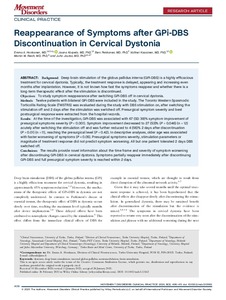Reappearance of Symptoms after GPi-DBS Discontinuation in Cervical Dystonia
Honkanen Emma A; Korpela Jaana; Pekkonen Eero; Kaasinen Valtteri; Reich Martin M; Joutsa Juho
Reappearance of Symptoms after GPi-DBS Discontinuation in Cervical Dystonia
Honkanen Emma A
Korpela Jaana
Pekkonen Eero
Kaasinen Valtteri
Reich Martin M
Joutsa Juho
WILEY
Julkaisun pysyvä osoite on:
https://urn.fi/URN:NBN:fi-fe2021042822513
https://urn.fi/URN:NBN:fi-fe2021042822513
Tiivistelmä
Background: Deep brain stimulation of the globus pallidus interna (GPi-DBS) is a highly efficacious treatment for cervical dystonia. Typically, the treatment response is delayed, appearing and increasing even months after implantation. However, it is not known how fast the symptoms reappear and whether there is a long-term therapeutic effect after the stimulation is discontinued.Objectives: To study symptom reappearance after switching GPi-DBS off in cervical dystonia.Methods: Twelve patients with bilateral GPi-DBS were included in the study. The Toronto Western Spasmodic Torticollis Rating Scale (TWSTRS) was evaluated during the study with DBS stimulation on, after switching the stimulation off and 2 days after the stimulation was switched off. Presurgical symptom severity and best postsurgical response were extracted from the hospital records.Results: At the time of the investigation, GPi-DBS was associated with 67 (SD 39)% symptom improvement of presurgical symptoms severity (P = 0.001). Symptom improvement decreased to 27 (53)% (P = 0.046) (n = 12) acutely after switching the stimulation off and was further reduced to 4 (56)% 2 days after discontinuation (P = 0.01) (n = 11), reaching the presurgical level (P = 0.42). In descriptive analyses, older age was associated with faster worsening of symptoms (P < 0.05). Presurgical symptoms severity, stimulation parameters or magnitude of treatment response did not predict symptom worsening. All but one patient tolerated 2 days DBS switched off.Conclusions: The results provide novel information about the time frame and severity of symptom worsening after discontinuing GPi-DBS in cervical dystonia. Symptoms partially reappear immediately after discontinuing GPi-DBS and full presurgical symptom severity is reached within 2 days.
Kokoelmat
- Rinnakkaistallenteet [27094]
